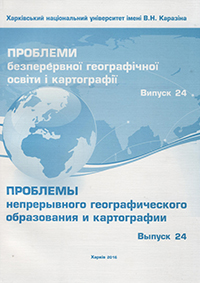Thermal conditions of the grape growing season within the North-Eastern steppe land of Ukraine (on the example of Kharkiv region)
Abstract
The article analyzes the results of the thermal conditions observations within the North-Eastern steppe land of Ukraine as one of the most important factors for successful cultivation of grapes, thus providing crop productivity. Considering the effect of thermal factors, it can be noted that the intensity and speed of life processes of plants are well- defined under temperature conditions only in the circumstances where other environmental factors are not limited. The thermal regime was initially taken into account in practice in XVII century. In XIX century the agro-climatic areas to grow grapes were determined in North-Eastern steppe land of Ukraine. Detailed studies of agro-climatic conditions of specific areas can more thoroughly to make conclusions and recommendations for the cultivation of grapes as a whole in the territory, and specifically in those areas were given. In studying the thermal balance of the territory the average and extreme temperature should be paid attention to. Characteristic features of the thermal regime are given in this paper based on the study of atmospheric phenomena, geomorphology and territories with radiation influence and water flow regime. Thermal treatment is subjected to anthropogenic influence, and in cultivating tenants can use appropriate agricultural practices (conceal bushes, warm soil and air, and even crops in protective ground, in greenhouses). Characteristically, technology of greenhouses growers is even used in Kherson region. These data can be used in neighborhood and the adjacent areas, especially they are useful for the practice of growing grapes. The possibility of successful cultivation of dozens of grape varieties in the North-Eastern steppe land of Ukraine has been well-grounded.
Downloads
References
2. Budivel`na klimatologiya [Building climatology. National Standard of Ukraine]. DSTU-N B V.1.1-27:2010. (Chy`nny`j vid 2011-11-01). Ky`yiv: Minregionbud Ukrayiny, 127.
3. Davitaja, F.F. (1952). Issledovanie klimatov vinograda v SSSR i obosnovanie ih prakticheskogo ispol’zovanija [The study of climates of the grapes in the USSR and the rationale for their practical use]. Moskva-Leningrad: Gidrometeoizdat, 304.
4. Dmy`trenko, V.P. (2011). Pogoda, klimat i urozhaj pol`ovy`x kul`tur [Weather, climate, and harvest field crops]. Ky`yiv: Nika-Centr, 620.
5. Nekos, A.N., Mal`chuk, O.V. (2015). Osobly`vosti koncentraciyi vazhky`x metaliv u vy`nogradi ta produktax jogo pererobky` [Especially the concentrations of heavy metals in grapes and products of its processing] Bulletin of V.N. Karazin Kharkiv National University. Ecology, 1147, 98-105.
6. Shulika, B.O. (2015). Aktual`ni problemy` rozvy`tku vy`nogradarstva u Pivnichno-Sxidnomu lisostepovomu krayi Ukrayiny` v svitli konstrukty`vnoyi geografiyi [Actual problems of development of viticulture in the North-Eastern forest-steppe region of Ukraine in the light of constructive geography]. Physical Geography and Geomorphology, 4 (80), 1, 87-91.
7. Derek, Mallia (2016). Western US wildfires in an increasingly warming climate. Available at: http://scitation.aip.org/content/aip/magazine/physicstoday/news/10.1063/PT.5.4021;jsessionid=dlIUovBkEd8rfXn2eXEQE6Xe.x-aip-live-06





